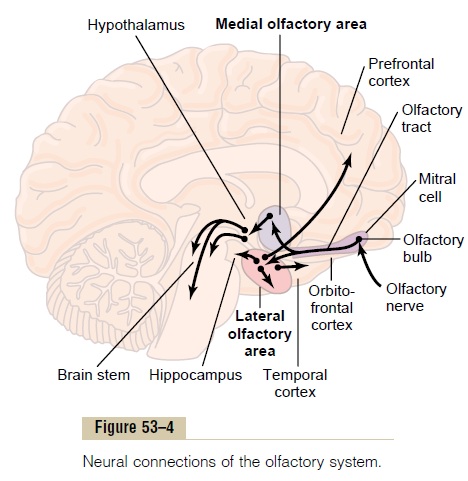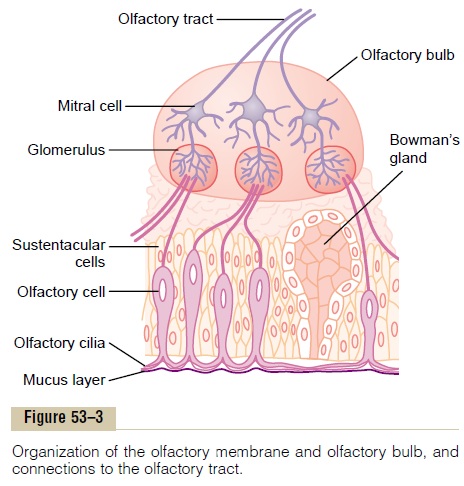Chapter: Medical Physiology: The Chemical Senses-Taste and Smell
Transmission of Smell Signals into the Central Nervous System
Transmission of Smell Signals into the Central Nervous System
The olfactory portions of the brain were among the first brain structures developed in primitive animals, and much of the remainder of the brain developed around these olfactory beginnings. In fact, part of the brain that originally subserved olfaction later evolved into the basal brain structures that control emotions and other aspects of human behavior;.
Transmission of Olfactory Signals into the Olfactory Bulb. The olfactory bulb is shown in Figure 53–4. The olfactorynerve fibers leading backward from the bulb are called cranial nerve I, or the olfactory tract. However,in reality, both the tract and the bulb are an anterior outgrowth of brain tissue from the base of the brain; the bulbous enlargement at its end, the olfactory bulb, lies over the cribriform plate, separating the brain cavity from the upper reaches of the nasal cavity. The cribriform plate has multiple small perforations through which an equal number of small nerves pass upward from the olfactory membrane in the nasal cavity to enter the olfactory bulb in the cranial cavity. Figure 53–3 demonstrates the close relation between the olfactory cells in the olfactory membrane and the olfactory bulb, showing short axons from the olfactory cells terminating in multiple globular structures within the olfactory bulb called glomeruli. Each bulb has several thousand such glomeruli, each of which is the terminus for about 25,000 axons from olfactory cells. Each glomerulus also is the ter-minus for dendrites from about 25 large mitral cells and about 60 smaller tufted cells, the cell bodies of which lie in the olfactory bulb superior to the glomeruli. These dendrites receive synapses from the olfactory cell neurons, and the mitral and tufted cells send axons through the olfactory tract to transmit olfactory signals to higher levels in the central nervous system.

Some research has suggested that different glomeruli respond to different odors. It is possible that specific glomeruli are the real clue to the analysis of different odor signals transmitted into the central nervous system.

The Very Old, the Less Old, and the Newer Olfactory Pathways into the Central Nervous System
The olfactory tract enters the brain at the anterior junction between the mesencephalon and cerebrum; there, the tract divides into two pathways, as shown in Figure 53–4, one passing medially into the medialolfactory area of the brain stem, and the other passinglaterally into the lateral olfactory area. The medial olfactory area represents a very old olfactory system, whereas the lateral olfactory area is the input to (1) a less old olfactory system and (2) a newer system.
The Very Old Olfactory System—The Medial Olfactory Area.
The medial olfactory area consists of a group of nuclei located in the midbasal portions of the brain immedi-ately anterior to the hypothalamus. Most conspicuous are the septal nuclei, which are midline nuclei that feed into the hypothalamus and other primitive portions of the brain’s limbic system. This is the brain area most concerned with basic behavior.
The importance of this medial olfactory area is best understood by considering what happens in animals when the lateral olfactory areas on both sides of the brain are removed and only the medial system remains. The answer is that this hardly affects the more primitive responses to olfaction, such as licking the lips, salivation, and other feeding responses caused by the smell of food or by primitive emotional drives associated with smell. Conversely, removal of the lateral areas abolishes the more complicated olfactory conditioned reflexes.
The Less Old Olfactory System—The Lateral Olfactory Area.
The lateral olfactory area is composed mainly of the prepyriform and pyriform cortex plus the cortical portion of the amygdaloid nuclei. From these areas,signal pathways pass into almost all portions of the limbic system, especially into less primitive portions such as the hippocampus, which seem to be most important for learning to like or dislike certain foods depending on one’s experiences with them. For instance, it is believed that this lateral olfactory area and its many connections with the limbic behav-ioral system cause a person to develop an absolute aversion to foods that have caused nausea and vomiting.
An important feature of the lateral olfactory area is that many signal pathways from this area also feed directly into an older part of the cerebral cortex called the paleocortex in the anteromedial portion of the tem-poral lobe. This is the only area of the entire cerebralcortex where sensory signals pass directly to the cortex without passing first through the thalamus.
The Newer Pathway. A newer olfactory pathway has nowbeen found that passes through the thalamus, passing to the dorsomedial thalamic nucleus and then to the lateroposterior quadrant of the orbitofrontale cortex. Based on studies in monkeys, this newer system prob-ably helps in the conscious analysis of odor.
Summary. Thus, there appear to be avery oldolfactorysystem that subserves the basic olfactory reflexes, a less old system that provides automatic but partiallylearned control of food intake and aversion to toxic and unhealthy foods, and a newer system that is com-parable to most of the other cortical sensory systems and is used for conscious perception and analysis of olfaction.
Centrifugal Control of Activity in the Olfactory Bulb by the Central Nervous System. Many nerve fibers that originatein the olfactory portions of the brain pass from the brain in the outward direction into the olfactory tract to the olfactory bulb (i.e., “centrifugally” from the brain to the periphery). These terminate on a large number of small granule cells located among the mitral and tufted cells in the olfactory bulb. The granule cells send inhibitory signals to the mitral and tufted cells. It is believed that this inhibitory feedback might be a means for sharpening one’s specific ability to distin-guish one odor from another.
Related Topics